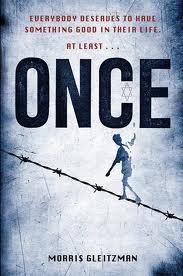By Holly Johnson, University of Cincinnati, Cincinnati, OH
–
Perhaps catastrophe is the natural human environment,
and even though we spend a good deal of energy trying to get away from it,
we are programmed for survival amid catastrophe.
–Germaine Greer
So, sometimes when we are standing on the edge of the next place, the next situation, the next move in our lives, we find ourselves pondering the concept of survival–survival of our ideologies and beliefs, our current relationships, or our lives as we know them. What might seem foreign to some readers is that many adolescents in the world are on the edge of survival in any or all of these ways. Survival can have a myriad of definitions, but for this entry, I want to think about the concept in respect to life, per se, or life as adolescents might know it from a particular social or economic location. What I love about the narratives highlighted this week is that the authors give young adults great reads that are relevant to readers’ lives regardless of genre. Some of the books are realistic fiction, others are science fiction/fantasy; still others are historical. One is a memoir turned into a graphic novel. All of them are entirely engaging and thought-provoking!
Two series I especially want to highlight are The Hunger Games (Collins, 2008) and the Chaos Walking (Ness, 2008) trilogies. Both are very popular and should be. They are well written and present heart-pounding adventures that keep readers glued to the text. When I finished The Knife of Never Letting Go, the first book of the Chaos Walking trilogy, I flipped! I wanted to start The Ask and the Answer immediately, but did not have it. Talk about a cliff-hanger! I loved it! And The Hunger Games did the same thing. Voice is what first struck me about both of these trilogies. Katniss Everdeen and Todd Hewitt, the adolescent protagonists, leap right out of the page in ways that are recognizable to adolescent readers while also serving as guides to a morality unrecognized by the characters of power within their respective narratives. Both Katniss and Todd reconcile the choices they have made that indeed threaten their physical survival, but they continue with their beliefs in spite of resistance and setbacks, which can truly inspire readers. And readers will recognize that survival is not only a concept, but a stark reality for many who choose to stand their ground in the face of powerful political opposition. I can’t think of a better way to engage young people who may be on the edge of becoming participating citizens.
Another text that presents an adolescent on the edge of survival is The Absolutely True Diary of a Part-time Indian (Alexie, 2007). This is the only book I know that can make the reader laugh and cry at the same time. It is poignant and powerful, and I use it to persuade teachers that the borders their students cross to succeed in school are indeed attempts to survive. I am convinced it should be a “must read” for anyone interested in education or teaching. Others include Revolver (Sedgwick, 2010), an historical piece of fiction set in the Arctic, where protagonist Sig Andersson, watching over the body of his dead father, is confronted with a stranger making demands while the Colt revolver—and Sig’s survival—make demands of their own. Winner of the Michael Printz Award, the best descriptor of this book is tension. Complete, hold-your- breath tension.
To round out the field, there are several other books worthy of discussion with adolescents who may wonder about surviving when confronted with circumstances beyond their control. Bamboo People (Perkins, 2010) is a piece of realistic fiction that chronicles how Chiko, a 15- year- old Burmese student, is forced into military service and eventually becomes imprisoned by a boy not much older than himself. Together they must decide how to overcome their anger and fear of each other so as to survive—together. Another text would be Fist, Stick, Knife, Gun: A Personal History of Violence (Canada, 1995/2010), a memoir by the American social activist who is currently the President of the Harlem Children’s Zone. Geoffrey Canada turned his memoir into a graphic novel that systematically explains how his escalating layers of violence were used as ways to survive in his youth. Absorbing, provocative, and educational, this text shows that Canada’s means of survival was ultimately just the opposite. Ninety Miles to Havana (Flores-Galbis, 2010) draws from the author’s experience as a young Cuban refugee who must learn to survive his move to Miami, Florida as well as the means by which he is enculturated into his new environment. Finally, there is Once (Gleitzman, 2005), a Holocaust story where 10-year-old Felix uses reading as his survival mechanism. Set in Poland in 1942, Once allows readers to consider the value of reading in their own lives. But more importantly, the novel also presents the power of the human spirit to strive toward survival in even the most dire of situations.
When I think about these texts and adolescents on the edge of survival, I have to note that quite often our physical, social, emotional, and economic survival is often all wrapped up together. Adults often have difficulty surviving some of the situations they encounter, and thus, how useful it would be to use texts that directly address how survival necessitates caring for each other and ourselves economically, emotionally, socially, and physically.
Journey through Worlds of Words during our open reading hours: Monday-Friday, 9 a.m. to 5 p.m. and Saturday, 9 a.m. to 1 p.m.
- Themes: Holly Johnson, Morris Gleitzman, Once, YA
- Descriptors: Debates & Trends, Student Connections, WOW Currents

